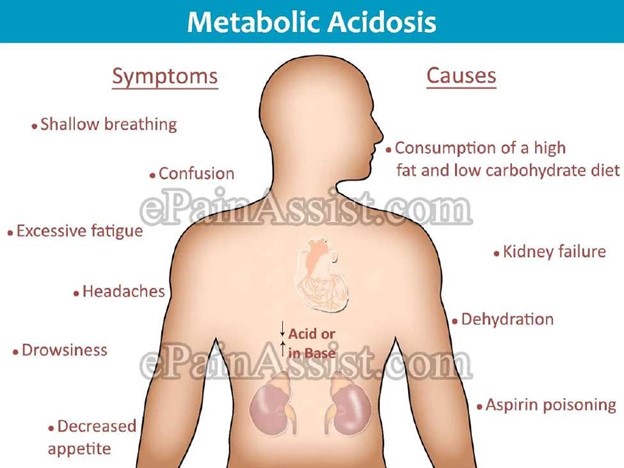A client is experiencing metabolic acidosis.
The nurse anticipates that the client’s respiratory rate will be:
Increased.
Decreased.
Normal.
Irregular.
The Correct Answer is A

Metabolic acidosis is a condition in which there is excess acid in the body fluids.
It causes rapid breathing, confusion, tiredness, headache, and increased heart rate.
Rapid breathing is a compensatory mechanism that helps to lower the carbon dioxide levels and increase the pH of the blood.
Choice B is wrong because decreased respiratory rate would worsen the acidosis by retaining more carbon dioxide and lowering the pH of the blood.
Choice C is wrong because normal respiratory rate would not be adequate to compensate for the metabolic acidosis and would result in acidemia (low blood pH).
Choice D is wrong because irregular respiratory rate is not a typical response to metabolic acidosis and could indicate other problems such as brain injury or drug overdose.
Nursing Test Bank
Naxlex Comprehensive Predictor Exams
Related Questions
Correct Answer is A
Explanation
The correct answer is A. 42 mL/h.
Choice A: 42 mL/h
Reason: To calculate the IV rate, we use the formula: IV rate (mL/h) = Total volume (mL) ÷ Total time (hours). For this problem, the total volume is 1000 mL and the total time is 24 hours. Therefore, the calculation is 1000 mL ÷ 24 hours = 41.6667 mL/h. When rounded to the nearest whole number, the IV rate is 42 mL/h. This makes 42 mL/h the correct answer.
Choice B: 44 mL/h
Reason: This choice is incorrect because it does not match the calculated IV rate. The calculation of 1000 mL ÷ 24 hours results in 41.6667 mL/h, which rounds to 42 mL/h, not 44 mL/h. Therefore, 44 mL/h is not a valid option based on the given data.
Choice C: 46 mL/h
Reason: This choice is also incorrect. The calculated IV rate of 41.6667 mL/h, when rounded to the nearest whole number, is 42 mL/h. There is no mathematical basis for rounding up to 46 mL/h from 41.6667 mL/h, making this choice invalid.
Choice D: 48 mL/h
Reason: This choice is incorrect as well. The correct calculation yields 41.6667 mL/h, which rounds to 42 mL/h. There is no justification for rounding up to 48 mL/h. This choice does not align with the calculated and rounded IV rate.
Correct Answer is ["A","B","D"]
Explanation

These are all signs and symptoms of hypokalemia, which is a condition where the blood potassium level is too low. This can affect the function of the muscles, nerves, and heart. Therefore, the nurse would expect to find these signs and symptoms in a client with dehydration and hypokalemia.
Choice C is wrong because hyperreflexia is not a sign or symptom of hypokalemia.
Hyperreflexia is a condition where the reflexes are exaggerated or overactive.
This can be caused by conditions such as spinal cord injury, stroke, or electrolyte imbalances such as hypocalcemia or hypomagnesemia.
Whether you are a student looking to ace your exams or a practicing nurse seeking to enhance your expertise , our nursing education contents will empower you with the confidence and competence to make a difference in the lives of patients and become a respected leader in the healthcare field.
Visit Naxlex, invest in your future and unlock endless possibilities with our unparalleled nursing education contents today
Report Wrong Answer on the Current Question
Do you disagree with the answer? If yes, what is your expected answer? Explain.
Kindly be descriptive with the issue you are facing.
